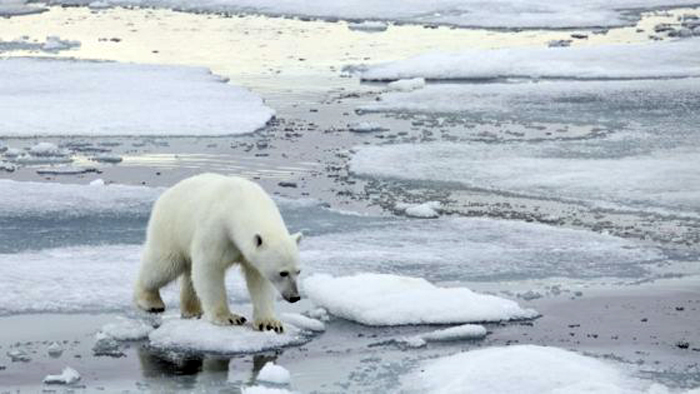Polar bears are working harder just to stay in one place, as the Arctic sea-ice on which they hunt drifts away.

US scientists have tracked the animals for nearly 30 years and find they have increased their activity levels.
Their normal behaviour is to stake out holes in the ice, waiting to prey on the seals as they emerge.
But the thinning pack in the warming Arctic is now drifting faster than it used to, and the bears must travel further to get back to their territory.
“If the drift is faster, and that prevailing drift is to the west, then in order for an Alaskan polar bear to remain an Alaskan polar bear, it must walk further or faster to the east on the ‘treadmill’, or it will end up in Russia,” explained David Douglas, a wildlife biologist at the US Geological Survey’s Alaska Science Center in Juneau.
Douglas was speaking in San Francisco, at the Fall Meeting of the American Geophysical Union – the world’s largest annual gathering of Earth scientists.
The USGS study he presented compared the movements of tagged female polar bears from the period 1987-1998 with a more recent group, from 1999-2013.
Their behaviours were combined with data on the status of the ice pack. This is now drifting through the Beaufort and Chukchi seas up to 6% quicker than it used to, as today’s thinner floes get pushed along more easily by the wind.
The analysis indicates the 1999-2013 bears have had to react to this greater speed by increasing their activity rates.
“We find that the bears in the recent period are 9-13% more active to compensate for the ice motion,” Mr Douglas told BBC News.
The USGS teamed up with animal physiologists at the University of Wyoming to try to calculate how many more calories the bears would need to consume in order to fuel the additional walking.
The specialists did this, but also converted the requirement into an estimate of the number of additional whole seals the bears would have to eat.
It is an increase of 2-7%, which equates to between one and four extra seals a year.
“Now, you might think that’s not a tremendous amount, but you have to keep in mind that that’s happening at the same time as their habitat to hunt seals is shrinking. So, it’s kind of a double whammy.”
And Mr Douglas added: “Where this may be particularly significant is in the recruitment of young into the population because the number of extra seals needed to compensate for the ice drift is higher for a mother that’s trying to nurture one-year-olds or two-year-olds; perhaps she’s got twins.
“Single adults may be able to survive this kind of stuff but it is the young that may be most vulnerable to this increased stress.”
Part of the issue is that polar bears become very tied to their particular sub-population in the Arctic.
The tracking data shows the animals have an extremely keen sense to try to get back to the territory they know.
As well as the University of Wyoming, the study called on expertise at the US Fish and Wildlife Service, the Canadian Wildlife Service, and Polar Bears International.
By Lubio Lenin Cardozo | Gustavo Carrasquel
Source BBC Science

No hay comentarios.:
Publicar un comentario